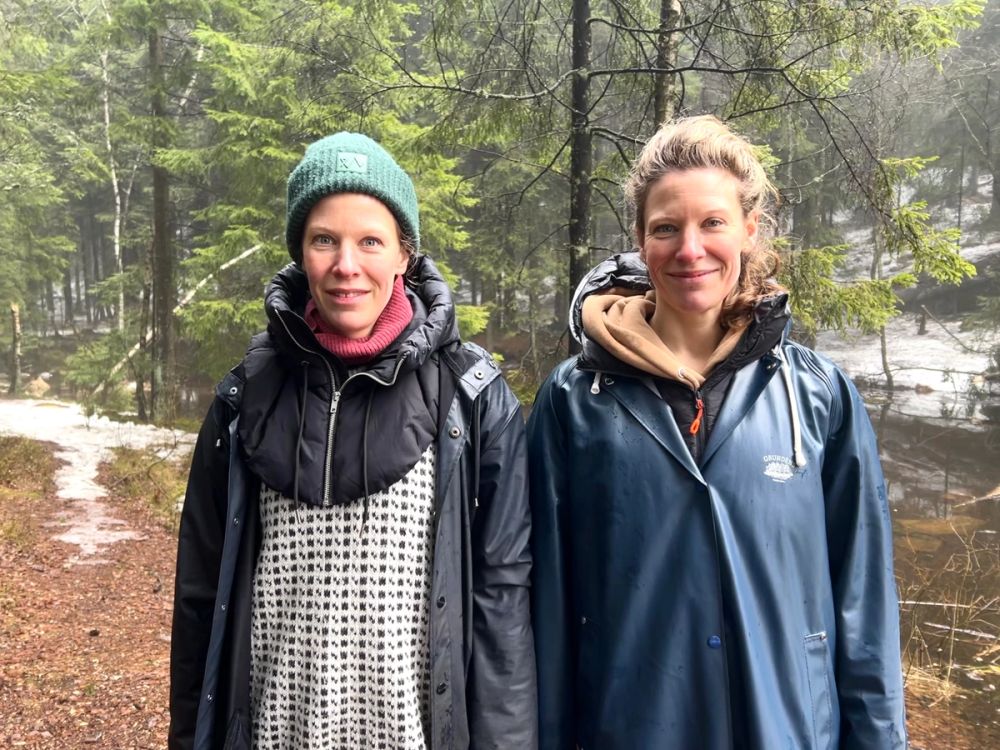Three questions for Julie and Cecilie Solberg

- Photo Anna Penkova
In DJUPVASSTRÅKK, Julie and Cecilie Solberg move the human body into a new element, the water. We are exited to join them at Isdammen in Årvoll in May and have asked them if they can tell us a little more about the project.
In DJUPVASSTRÅKK, you will take the audience out of the theater hall, into the forest and further into the water!? Would you like to tell us a little more about what is the inspiration for this performance?
Yes! We're going out in the spring, here the table is set for an "outing" atmosphere, so I hope everyone remembers to wear good clothes. The first inspiration came some time after Songs of entanglement, our previous performance together, where we worked based on the personal, our bodies, voices and interaction. We fantasized about a more or less impossible project of being able to disappear away from the personal, to be erased as persons, to be more of a kind of shell, a mask or part of a fiction. We will probably never be able to do that, was our first thought. The body itself takes a lot of focus on stage, and we are two alike. But could we disappear into something bigger, be absorbed, absorbed in something else or find a stronger partner? Nature, the water, is such an accomplice, a strong and demanding accomplice. In addition to this, DJUPVASSTRÅKK draws inspiration from many sources. If we were to single out some works, we could mention Alma Söderberg's work with silence, rhythm, sound and thoughts around an alert body, the subtlety of the bodily work of Giselle Vienne, we cannot leave out the performance Night Tripper by Fiksdal/Langgård/Becker, as well the old Dutch group Bewegingstheater BEWTH.
Where does this fascination with water come from?
Initially, we wanted the illusion of a waterhole. During our residency at Figurteateret in Stamsund, we investigated the use of real water in the stage space. We were simply enchanted by the nature of the element and how we identify and fabulate in the face of the element. We wanted more and bigger. Throughout the process, we were constantly reminded how political water is in our time, for example we had challenges with access to water for a stage room due to empty water reservoirs and restrictions in Oslo. This led us out into nature.
The water is a mirror, it reflects our inner self, in a kind of dreamlike way, and thus becomes a catalyst for associations on many levels. Our starting point has not only been the fascination for water as an element, but nature in man. We would see man as part of a natural program, as part of nature's cycle. On the way in this process, we discovered Astrida Neimani's thoughts on Hydrofeminism and it was the most all-consuming perspective we have encountered. I'm in you, you're in me, we're in water, water is in us, I'm drinking pre-historic waste and the water will (most likely) outlive us.
We thought it was exciting to imagine humans from a perspective from above, where we are like blades of grass on the lawn (or in the field, if you like). Evoking a contrast to an individualistic view of humanity; How unique am I as a human being? Questions related to what we see as natural in humans, original and copy, nature and culture are raised. Originality and acts of genius disappear in such a perspective; before long the blade of grass is withered and dead.
You are twins and have previously staged your relationship in the performance Songs of Entanglement. Can you tell us a bit about how you work together as artistic collaborators?
We work together because some themes and ideas have a very good breeding ground between us. As in all collaborations, we work both well and poorly together. We probably work very well together, when we work well together and correspondingly poorly, you know how it can be with siblings. Then we have with us very talented and good people in the artistic team, and nothing happens without them.
When it comes to the interaction between the two of us as performers, we try to ask ourselves the question: What triggers good artistic processes? In our case, it's about trying to reinforce what we have of ideas or physics between us. We are both interested in the body's potential to single-handedly transform spaces and thus lead the audience into fictional spaces or create associations. We both come from a physical approach to theatre, and from within, in the performer's head, we probably play theatre, even if the work can seem more abstract. Our work springs from and comes into existence in the fact that we are performers. It is through doing that we think and best understand what we are doing. In this sense, the trial period is very important and everyone who is part of it.
Then we know each other very well, especially when it comes to physical interaction and reading each other's bodies. We grew up on a farm in Gokk, and we probably have this with us as a backdrop to the collaboration. In DJUPVASSTRÅKK, animals and manual work, for example, have been both inspiration and a way in which we have approached physical work. In Songs of entanglement, we worked from a playful community in sports and competitions, and singing and voice work.
DJUPVASSTRÅKK will be shown 3–6. May at Isdammen in Årvoll.








